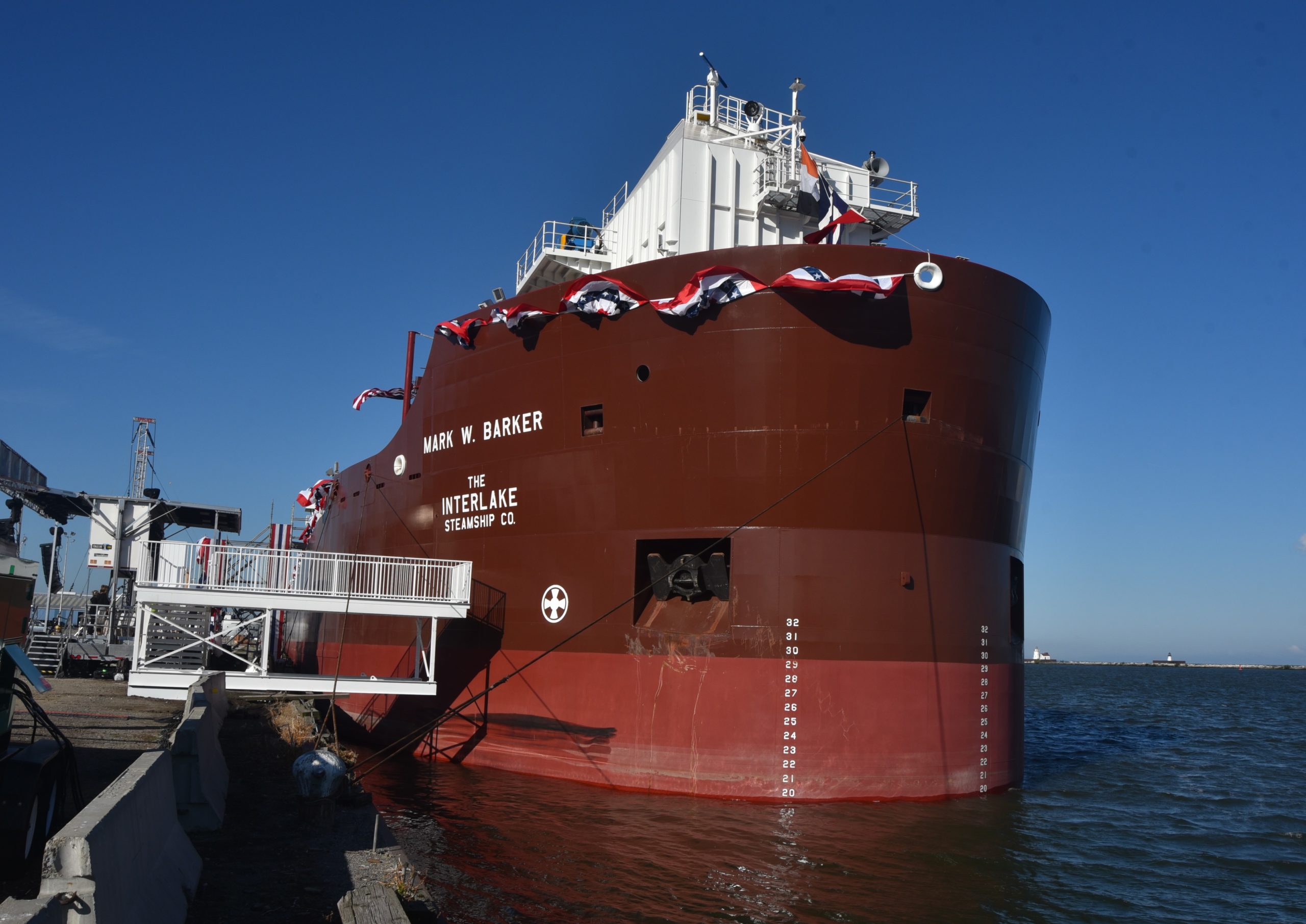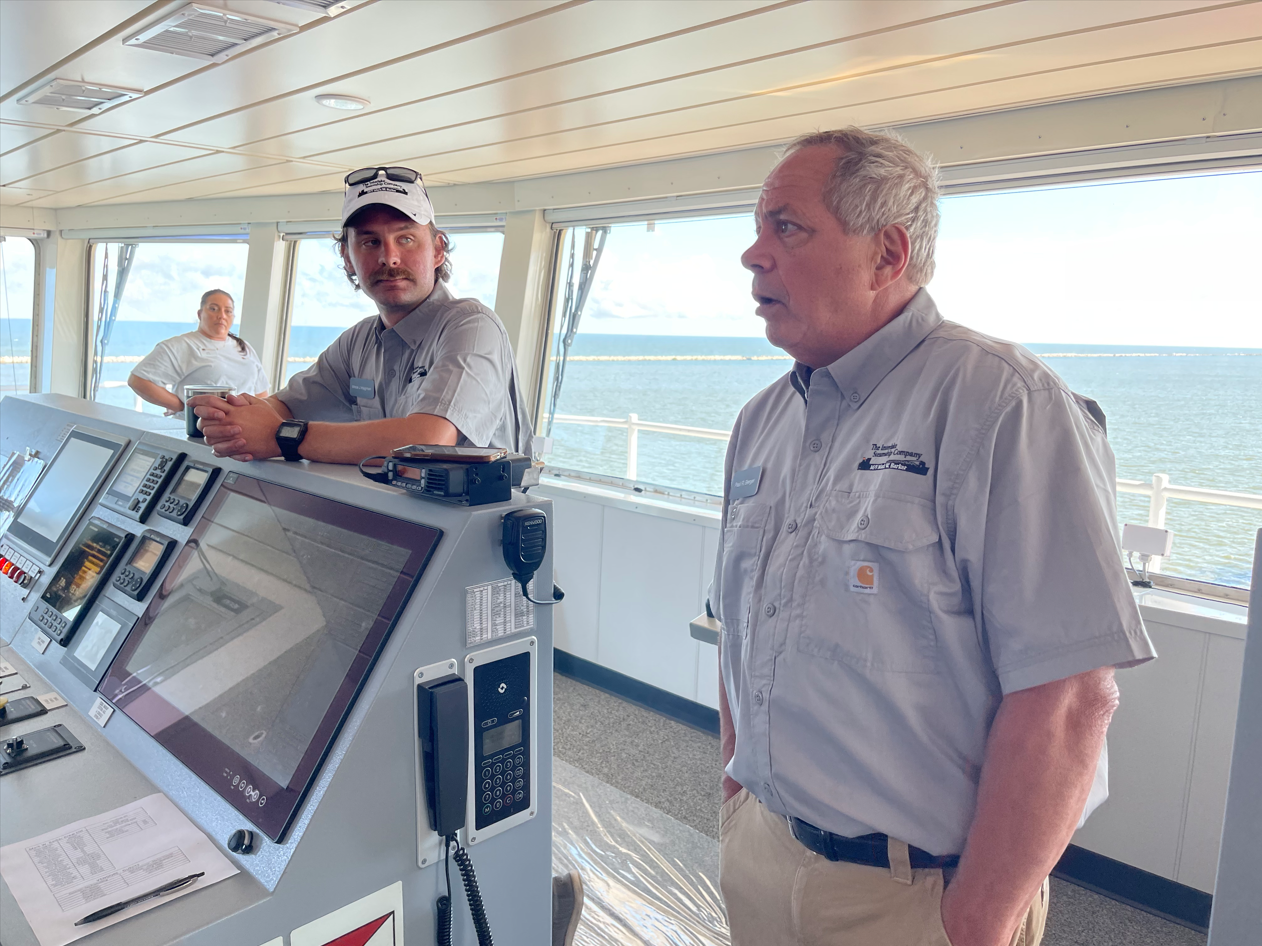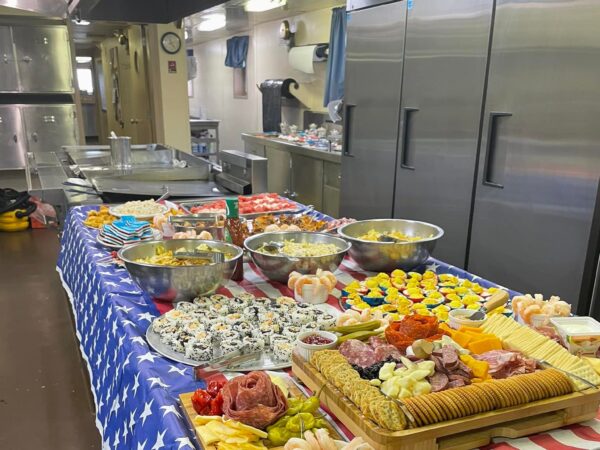
For the first time in decades, a new bulk freighter has been built on and launched on the Great Lakes.
The Fincantieri Bay Shipbuilding Company in Sturgeon Bay, Wisconsin unveiled the Mark W. Barker earlier this year after spending nearly three years constructing it. The vessel was commissioned by Cleveland-based Interlake Steamship Company which currently operates about a dozen ships.
“This is the first (new) ship in more than 35 years,” said Jim Weakley, president of the Lake Carriers Association, a trade group that represents American Great Lakes shipping fleets. “We’ve had a couple tug barges built in the past decade, but this is the first ship in a long time. The beauty of our environment is these are freshwater ships, and they last a long time. They don’t corrode like saltwater ships do and we maintain them.”
Here’s a playlist of Great Lakes Now’s video segments about the shipping industry:
Weakley said that in just the past decade Interlake has invested more than $100 million into its existing fleet including engines, hull fabrications and updated electronics.
“On the deep sea environment, they’re building new ships and scrapping some of their fleet, but on the Great Lakes we’re rebuilding,” he said. “This is the first new ship for the entire U.S.-flagged fleet.”
There are new lake freighters in the Canadian fleet, according to Weakley, but they’re not currently being produced in the U.S. or Canada, they’re being built overseas after government officials eliminated requirements for domestic production.
“The Canadians are building, but they’re building in China and Croatia,” he said. “Canada is a perfect example of how not to support your merchant marine. All their shipyards went bankrupt. They’re building poor quality ships and then they’re scrapping ones they had in their fleet and a couple of them literally sunk in the Atlantic Ocean. But we invest for the long term.”
In fact, Weakley said, American-made ships last so long on the Great Lakes that one ship built in 1906 was recently converted from a self-propelled ship to a tug barge and is still being used today.
“The St. Mary’s Challenger is probably the longest-serving commercial ship in the history of the world. It operated as a ship for over 100 years – even the Phoenicians couldn’t pull that one off,” he said, laughing.
Innovative features make Mark W. Barker a ship for all commodities
The 639-foot vessel has made more than 10 voyages so far. Its intended use is for moving up to 26,000 tons of road salt, plus a host of other bulk commodities such as limestone, iron ore and coal between Great Lakes ports. It could also be used to transport food commodities like wheat or corn. The vessel can move the same amount of materials as 250 railroad cars or 1,000 tractor trailer loads.
Quick Facts
- 639 feet in length
- 8,000 horsepower (2 engines, 1 prop)
- 78-foot beam
- 45-foot hull depth
- 26,000 tons gross capacity
But because of new features in the design, bulk commodities aren’t the only suitable freight categories for the M/V Barker. Its cargo hatches are able to slide and stack atop one another allowing for large items like wind turbine blades, steel coils, bridge components and oversized machinery and equipment to be lowered and transported inside the hold. The ship can also accommodate container freight, if needed. Its five 50-ton cargo hatches are structurally designed to withstand the stacking of freight atop them.
Unlike most lake freighters, the cargo hold’s interior walls are not sloped on the sides, which increases capacity and functionality for non-bulk cargo.
The vessel features a 250-foot bow-mounted unloading conveyor boom which makes it much more versatile than most other self-unloading bulk carriers which usually feature rear-mounted versions.
“There’s a conveyor belt that runs the full length of the ship,” said Mike Terry, conveyorman, who added the bulk cargo drops through a gate on the ship’s floor before being ferried out on a belt system and delivered dockside. “There are 34 automated gates, and we can open them to whatever set, pre-determined amount we want to unload, and I can swing the boom in or out. I also have a camera so I can keep an eye on the pile and put it exactly where the customer wants it.”
He said customizing delivery is a huge efficiency boost for customers since it means they don’t have to re-handle material after it’s unloaded.
And since the cargo hold’s interior is straight-walled instead of pitched, it can accommodate front-end loaders inside which are used to speedily dispatch the last of the cargo onto the conveyor belt.
While Interlake could have commissioned a larger vessel, the Barker’s size is intended to make it a master of many tasks — and small enough to easily navigate rivers like the Cuyahoga in Cleveland and other ports’ waterways which may feature restricted space and shallow depth. The 1,000-horsepower electric bow and stern-mounted thrusters make it especially maneuverable without the aid of tugboats.
Lots of power, eco-friendlier
A pair of 16-cylinder EMD turbocharged diesel engines, similar to what train locomotives use, combine to provide 8,000 horsepower to the vessel, with each cylinder a massive 710 cubic inches.
In the engine control room, 27-year mariner veteran Erik Wlazlo, M/V Barker’s chief engineer, shows off a modern computerized control system.
“This replaces all the valves and gauges, they’re pretty much right here these days,” he explained, pointing toward a bank of computer screens. “Engine pressures, temperatures, pumps and everything is right here. Periodically we’re an unattended engine room so we have these panels in our state rooms where we could operate pumps and valves from there in case of an emergency so we wouldn’t have to come down here.”
Related:
- Can shipping on the Great Lakes take the next step toward transporting high-value container cargo?
- The 2022 Great Lakes shipping season sets sail after COVID-19 hurdles
- Sustainable Shipping: The Port of Montreal’s role as the Great Lakes’ green gateway
Wlazlo said the ship meets all the latest emissions requirements, called Tier 4, including its main engines and generators. In fact, he said, the engines on the Barker are the first 16-cylinder Tier 4 engines EMD’s made, as well as the first Tier 4 C-34 generator made by Caterpillar. U.S. Environmental Protection Agency Tier 4 regulations significantly reduce nitrogen oxide, particulate matter and hydrocarbons emissions on ships, ferries, tugs and government vessels.
One advantage, he said, is that the newest pollution-control technology utilized on the Barker no longer includes caustic soda, a substance especially dangerous for crew members to work with, and instead features more people and environmentally friendly materials.
“We inject a diesel exhaust fluid similar to what over-the-road trucks use,” he said. “And we’d typically burn about 5,000 gallons a day of ultra-low sulfur diesel fuel.”
Crew members work hard, eat well
“It’s interesting,” said chef Matt Dillinger, the man in charge of feeding the ship’s roughly 20 crew members for 60 days straight. “There’s days when you’re the only shining spot when everyone’s having a bad day and it’s good to be that shining spot.”
He said breakfast prep begins before dawn, there’s a lunch-hour soup every day, and then a dinner. Snacks, cookies, fresh fruit, baked goods and ready-to-go lunches and meals are always prepared and available for folks who get stuck working during meal times.
Dillinger was a deckhand on the Great Lakes nearly 20 years ago, leaving to attend culinary school. Then he returned to the lakes, this time in the galley. He said getting supplies is usually simple, though sometimes can be tricky – especially when they don’t actually dock and tie off.
“Up at the Soo Locks, they have a little tugboat with a crane on it and they’ll come alongside and lift pallets with supplies aboard,” he said. “Everything from our food to our dry goods to engine room supplies. But in most places, we’ll have suppliers run to GFS or a local grocery store and they’ll bring it down in a truck or a van or whatever.”
A staple list of menu items never gets old, Dillinger said. But some things are loved by a few and hated by many, like liver. In the case of crew members that love it, he always makes a second choice, like spaghetti and meatballs or another guaranteed favorite, for the liver haters.
Seasoned captain for new ship
Captain Paul Berger has been on the lakes for ages, beginning with 15 years as a ferry captain in the Lake Erie islands region. Since then, he’s captained a tug barge, a 1,000-foot freighter and other ships for Interlake. He said the Barker is definitely a new breed of lake freighter.
“We now have a PA system throughout the whole ship, talkback speakers out on deck,” he said. “And the general alarm system is now on speakers as opposed to individual bells. You push ‘All Call’ to make an announcement, and everybody hears it.”

Captain Paul Berger and Relief Captain Vince Hagman talk with reporters on the bridge of the Mark W. Barker. (Photo Credit: James Proffitt)
As an example, Berger cited a previous ship he captained utilizing a system of individual bells numbering 100-plus, of which a half dozen every year would corrode and malfunction. And on the Barker he said, visibility from the bridge is unparalleled, which he learned during ship trials.
“I was amazed, I was making the dock coming back in that night standing at the window and I thought ‘Oh my God, I can see everything,’” he said. “We have these fancy cameras which I don’t even turn on but the young guys like that stuff. I just look out the window.”
As a caveat, he said he’ll definitely use the bow camera to see whether fishing boats are moving out of the way. And as far as maneuverability in tight quarters, such as the Cuyahoga River, he deferred to Vince Hagman, relief captain.
“Compared to other boats, this boat handles very well with the thrusters. The rudder goes over to 65 degrees which is not typical, usually you get a 40-degree rudder angle,” Hagman said. “So when you give this boat some engine and get the thrusters going – I’ve never had a boat turn too fast in the Cuyahoga until I’d driven this one. I was very happy the way this boat handled, it was a real treat.”
Berger said Fincantieri’s fire detection and PA systems are new to Interlake crew, so there was a learning curve there. Engine control systems are unique, he said, as well as the entire unloading system which is completely controlled by computer screen. Caterpillar front loaders used inside the cargo hold, which he pointed out no other lakers have, are also new to the crew.
Domestic Bliss
“The Mark Barker is a different ship not just for us but for the Great Lakes. It’s a Cleveland-designed ship here to support some very well-established, well-regarded Cleveland names, namely Cargill and Cleveland Cliffs,” said Brendan O’Connor, vice-president of marketing and marine traffic for Interlake. “This ship is the most capable on the Great Lakes for navigating restricted areas on the lakes.”
In addition to its unique cargo capabilities and service for established customers, O’Connor emphasized the extreme domestic nature of the vessel.
“It was built by an American shipyard, it’s an American-flagged vessel, it’s crewed by American sailors, it was built by American laborers, it moves American products, and it is owned by an American company with roots that go back 130 years,” he said. “The iron ore that supports the steel industry comes from the head of the lakes up in Minnesota or Michigan, that is mined by American workers and is then moved to a steel mill that might be in Illinois, Indiana or Ohio. And that forms steel and that steel is then used to build the ships that move the raw materials supporting the miners that support the mariners and it’s a great continuum of the American production that we so focus on.”
Catch more news at Great Lakes Now:
Sustainable Shipping: At the Port of Milwaukee the wind blows toward a greener future
Sustainable Shipping: Burns Harbor port tries to green Indiana’s industrial coast
Featured image: The Mark W. Barker empty and riding high on the shore at Cleveland the day before her Ohio christening. (Photo Credit: James Proffitt)




